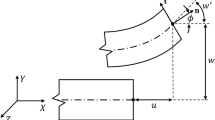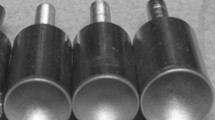Abstract
A combined theoretical and experimental study of a crack growth in a mixed-mode I–II loading is presented. A 160×40×20 mm marble beam, with an artificial crack 8 mm and 10 mm long each, was subjected to three point bending. The crack was located vertically to the beam's lower longitudinal fiber, through the whole width of the beam. The position of the crack was displaced from the center of the beam to one of the supporting points. The vertical force P, placed on the middle of the upper fiber of the beam, imposed the combination of the opening (mode I) and the sliding (mode II) modes on the crack mouth, creating the mixed-mode I–II loading case. The stress intensity factors K I and K II, which describe the local stress and strain field around the crack tip, were determined by a suitable finite element program. The crack growth was defined by two classical fracture criteria of LEFM; the minimum strain energy density and the maximum circumferential stress criteria. The initial crack growth angle (θ) was calculated from both criteria and the critical load (P c) from the minimum strain energy density (SED) criterion. These theoretical predictions were compared with some experimental results found from three marbles with different elastic constants; the Krystallina of Kavala, the Snow-white of Thassos and the White of Piges Drama. The theoretical results showed the same trend of θ and P c as the experimental ones and they are in good agreement.
Similar content being viewed by others
References
E.Z.Lajtai, Brittle fracture in compression, International Journal of Fracture 10(4) (1974) 525–536.
J.-P.Petit and M.Barquin, Can natural faults propagate under mode II conditions? Tectonics 7(6) (1988) 1243–1256.
O. Reyes and H.H. Einstein, Failure mechanisms of fractured rock—A fracture coalescence model, Proceedings, 7th International Conference on Rock Mechanics, W. Wittke (ed.), Balkema (1991) 333–340.
B.Shen and O.Stephansson, Numerical analysis of mixed mode I and mode II fracture propagation, International Journal of Rock Mechanics, Mining Science and Geomechanics Abstracts 30 (1993) 861–867.
E.E.Gdoutos, Problems of Mixed Crack Propagation, Martinus Nijhoff Publishers, Netherlands (1984).
E.E.Gdoutos and D.A.Zacharopoulos, Mixed mode crack growth in plates under three point bending, Experimental Mechanics 27 (1987) 365–369.
B.K. Atkinson and P.G. Meredith, Experimental fracture mechanics data for rocks and minerals, Fracture Mechanics of Rock, B.K. Atkinson (ed.), Academic Press, Geology Series (1987) 477–526.
B.N.Whittaker, R.N.Singh and G.Sun, Rock Fracture Mechanics. Principles, Design and Applications, Elsevier Science Publishers B.V., Netherlands (1992).
G.C.Sih, Strain-energy-density factor applied to mixed mode crack problems, International Journal of Fracture 10 (1974), 305–321.
G.S. Xeidakis and I.S. Samaras, Rodope marbles. A study of their main physical and engineering properties, Proceedings, 7th National Conference of Hellenic Geological Society (1994) in Greek.
Author information
Authors and Affiliations
Rights and permissions
About this article
Cite this article
Xeidakis, G.S., Samaras, I.S., Zacharopoulos, D.A. et al. Crack growth in a mixed-mode loading on marble beams under three point bending. Int J Fract 79, 197–208 (1996). https://doi.org/10.1007/BF00032936
Received:
Accepted:
Issue Date:
DOI: https://doi.org/10.1007/BF00032936




